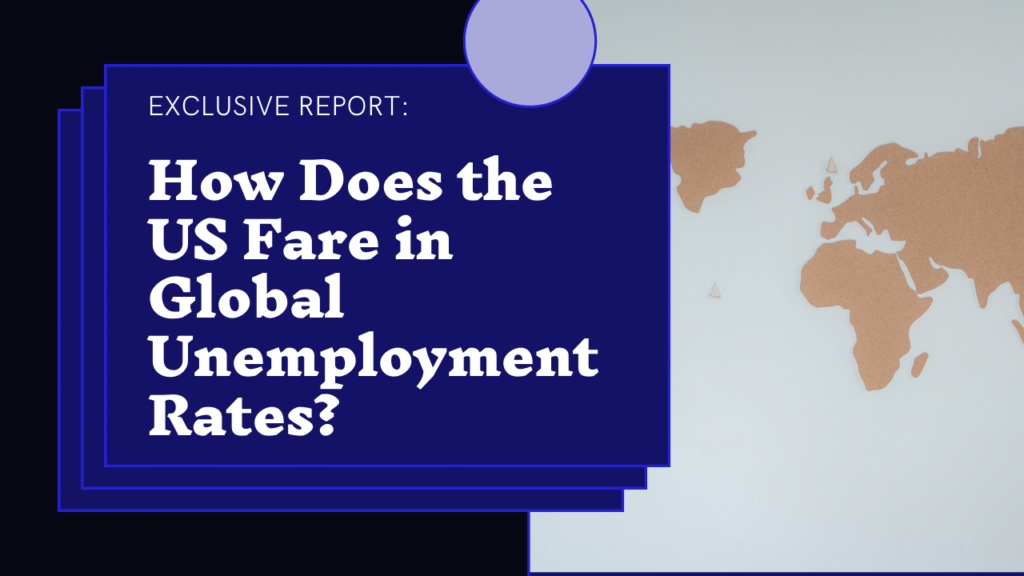Across the globe, a tale of two economies is unfolding. While some nations grapple with skyrocketing unemployment, others bask in near-full employment. Where does the United States stack up in this economic jigsaw puzzle? Buckle up, folks, because we’re about to embark on a deep dive into the world of unemployment rates, uncovering insights that might surprise you.

Understanding the Numbers:
Let’s begin with a snapshot of the unemployment landscape. As of November 2023, the US boasts a respectable 3.7% unemployment rate. Compared to giants like South Africa (31.9%) and Spain (11.84%), the US picture seems rosy. But delve deeper, and nuances emerge. Compared to low-unemployment havens like Japan (2.5%) and Switzerland (2.1%), the US has some ground to cover.
Global Unemployment Rates: A High-to-Low Look (November 2023)
| Country | Unemployment Rate | Country | Unemployment Rate |
|---|---|---|---|
| South Africa | 31.9% | Japan | 2.5% |
| Spain | 11.84% | Switzerland | 2.1% |
| Turkey | 8.5% | Singapore | 2.0% |
| Italy | 7.8% | South Korea | 2.8% |
| Brazil | 7.6% | Mexico | 2.7% |
| France | 7.4% | Canada | 5.8% |
| India | 7.1% | Germany | 5.9% |
| Argentina | 5.7% | Netherlands | 3.5% |
| Indonesia | 5.32% | Russia | 2.9% |
| China | 5.0% | United States | 3.7% |
| Saudi Arabia | 4.9% | United Kingdom | 4.2% |
| Australia | 3.9% |
Note: This table presents a snapshot of unemployment rates as of November 2023. Rates can fluctuate monthly, so it’s important to check for the latest updates.
Also Read: Unemployment Rate and Fed’s interest rate Decision
Factors Shaping the Landscape:
So, what forces are molding these diverse unemployment landscapes? A complex interplay of factors comes into play:
- Economic Growth: A thriving economy creates jobs, naturally impacting unemployment. Countries like China and Saudi Arabia, with robust economic expansion, often experience lower unemployment.
- Labor Market Dynamics: Ageing populations, skill gaps, and labor regulations can influence employment rates. Japan, with an aging population, faces unique challenges compared to a younger country like Indonesia.
- Government Policies: Social safety nets, unemployment benefits, and job training programs can influence how quickly people re-enter the workforce after job losses.
Unequal Impact: A Shadow Over US Job Growth
While the headline unemployment rate in the US paints a picture of recovery, a closer look reveals troubling disparities. Certain demographics, like young adults and minorities, continue to face significantly higher unemployment rates, highlighting a crucial economic challenge: equitable access to opportunity.
Young Adults: Recent graduates and young adults often struggle to find their footing in the labor market. Factors like inexperience, lack of connections, and competition from older, more qualified candidates contribute to higher unemployment among this group. This can have long-term consequences, impacting career trajectories, earning potential, and overall economic well-being.
Minorities: Racial and ethnic minority groups consistently face higher unemployment rates compared to the white population. This disparity stems from systemic inequalities in education, job opportunities, and wage discrimination. Addressing these systemic issues through targeted policies and affirmative action programs is crucial to leveling the playing field and ensuring equal access to economic prosperity.
Wage Stagnation: Even with jobs returning, many Americans are struggling to make ends meet. Wage growth has simply not kept pace with inflation, leading to stagnant earnings and shrinking purchasing power. This particularly impacts low-wage earners and families, who face a growing struggle to afford basic necessities like housing, food, and healthcare. The widening gap between the rich and the poor raises concerns about income inequality, eroding social mobility and threatening overall economic stability.
Automation and AI: While technological advancements promise progress, they also pose threats to certain jobs. As automation and artificial intelligence (AI) become more sophisticated, tasks traditionally performed by humans are increasingly being automated. This threatens job displacement in sectors like manufacturing, transportation, and retail. The key to mitigating this disruption lies in investing in education and training programs that equip workers with the skills and knowledge needed to thrive in the evolving job landscape. Focus on areas like coding, data analysis, and soft skills like critical thinking and problem-solving can help workers adapt and transition to new opportunities.
Addressing these challenges requires a multi-pronged approach:
- Policy interventions: Government policies promoting job creation, wage growth, and affordable housing can help alleviate economic pressures.
- Investment in education and training: Equipping workers with the skills needed for the future economy is crucial to mitigating job displacement and ensuring employability.
- Breaking down systemic barriers: Addressing discrimination and promoting equal access to opportunities is essential for creating a truly equitable economic system.
- Encouraging worker collaboration: Strong worker unions and advocacy groups can play a vital role in negotiating fair wages and protecting workers’ rights.
By acknowledging the unequal impact of economic trends and actively working towards solutions, we can create a future where all Americans have a fair shot at economic security and prosperity.
The Road Ahead:
Navigating the global jobs puzzle requires a multi-pronged approach:
- Stimulating Economic Growth: Policies that encourage investment, innovation, and entrepreneurship can fuel job creation.
- Investing in Human Capital: Education and training programs that equip workers with in-demand skills can boost employability.
- Enhancing Labor Market Flexibility: Measures that incentivize job mobility and address skill gaps can facilitate smoother transitions in the changing workplace.
- Supporting Vulnerable Groups: Targeted policies and resources can help marginalized communities gain access to employment opportunities.
The Takeaway:
Understanding the global unemployment landscape reveals both the US’s relative strengths and the challenges it faces. By acknowledging the complexities and actively addressing them, policymakers and individuals can work towards a future where everyone has a fair shot at secure and fulfilling employment.
